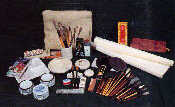Classification of Chinese Traditional Painting
 |
|
Four treasures of the study |
1. Techniques
According to painting techniques, Chinese painting can be divided into two styles: xieyi style and gongbi style. Xieyi, or freehand, is marked by exaggerated forms and freehand brushwork. Gongbi, or meticulous, is characterized by close attention to detail and fine brushwork. Freehand painting generalizes shapes and displays rich brushwork and ink techniques.
2. Forms
The principal forms of traditional Chinese painting are the hanging scroll, album of paintings, fan surface and long horizontal scroll. Hanging scrolls are both horizontal and vertical, usually mounted and hung on the wall. In an album of paintings the artist paints on a certain size of xuan paper and then binds a number of paintings into an album, which is convenient for storage. Folding fans and round fans made of bamboo strips with painted paper or silk pasted on the frame. The long, horizontal scroll is also called a hand scroll and is usually less than 50 centimeters high but maybe up to 100 meters long.
3. Subjects
Traditional Chinese paintings can be classified as figure paintings, landscapes and flower-and-bird paintings. Landscapes represent a major category in traditional Chinese painting, mainly depicting the natural scenery of mountains and rivers.
The range of subject matter in figure painting was extended far beyond religious themes during the Song Dynasty (960-1127). Landscape painting had already established itself as an independent form of expression by the fourth century and gradually branched out into the two separate styles: blue-and-green landscapes using bright blue, green and red pigments; and ink-and-wash landscapes relied on vivid brushwork and inks. Flower-and-bird painting deviated from decorative art to form its own independent genre around the ninth century.
Traditional Chinese painting, poetry, calligraphy, painting and seal engraving are necessary components that supplement and enrich one another. "Painting in poetry and poetry in painting" has been a criterion for excellent works. Inscriptions and seal impressions help explain the painter's ideas and sentiments and also add beauty to the painting.










